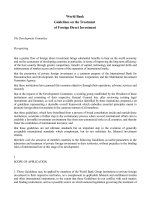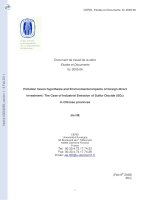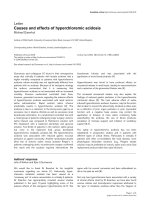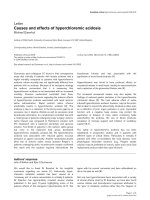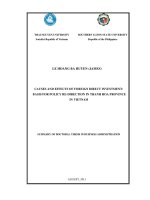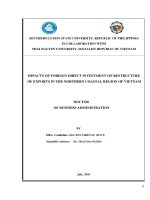Causes and effects of foreign direct investment basis for policy re direction in thanh hoa province in viet nam
Bạn đang xem bản rút gọn của tài liệu. Xem và tải ngay bản đầy đủ của tài liệu tại đây (2.12 MB, 150 trang )
CAUSES AND EFFECTS OF FOREIGN DIRECT INVESTMENT:
BASIS FOR POLICY RE-DIRECTION IN THANH HOA
PROVINCE IN VIETNAM
___________________________
A DISSERTATION
Presented to the Faculty of the Graduate School
Southern Luzon State University, Lucban, Quezon, Philippines
in Collaboration with
Thai Nguyen University, Socialist Republic of Vietnam
___________________________
In Partial Fulfillment
of the Requirements for the Degree
Doctor of Business Administration
___________________________
By
LE HOANG BA HUYEN (JAMES)
December 2013
i
APPROVAL SHEET
ii
CERTIFICATE OF ORIGINALITY
iii
ACKNOWLEDGMENT
The researcher would like to thank Thai Nguyen University, the
International Centre Education of Thai Nguyen University, and Southern
Luzon State University for guiding him throughout this research, providing
him with the opportunity to conduct this research and helping him to carry out
the necessary revisions to the thesis. He would like to extend his gratitude,
specifically to the following:
Dr. Cecilia N. Gascon, President of Southern Luzon State University
and Dr. Dang Kim Vui, the President of Thai Nguyen University, who made
possible the linkage between Thai Nguyen University with Southern Luzon
State University, the offering of Doctor of Business Administration, through the
ITC-TUAF;
Dr. Tran Dai Nghia, for his support and supervision throughout his
graduate study program. His kindness and daily instructions in the last years
are greatly appreciated and this dissertation is as much as his work as the
researcher;
Dr. Nguyen Manh An, President of Hong Duc University, his
colleagues at the Faculty of Economic and Business Administration, Hong Duc
University, and his friends, for their support and encouragement during the
the completion of the dissertation;
His parents, for giving him constant support and encouragement and
for always believing in him;
iv
His wife, Nguyen Thi Tam, who always support him throughout his
study more than anything else;
His energetic daughters (Giang Huong and Tra Giang), who provides
him laughter whenever he is weary and inspires him to pursue his goal;
His dear friends, who instilled within him a love of creative pursuits,
science and language, all of which finds a place in this the dissertation; and
Finally, he would like to thank the local government of Thanh Hoa
Province, foreign companies in Thanh Hoa province for providing him with
information to conduct this research, and feedback necessary for making this
dissertation successful.
LE HOANG BA HUYEN
v
DEDICATION
This academic pursuit is dedicated to my parents
my wife, Nguyen Thi Tam, and my daughters ,
Giang Huong and Tra Giang .
LHBH
vi
TABLE OF CONTENTS
PAGE
TITLE PAGE ………………………………………………………………..
i
APPROVAL SHEET ……………………………………………………….
ii
CERTIFICATE OF ORIGINALITY ………………………………………..
iii
ACKNOWLEDGEMENT …………………………………………………..
iv
DEDICATION ………………………………………………………………
vi
TABLE OF CONTENTS …………………………………………………..
vii
LIST OF TABLES ………………………………………………………….
ix
LIST OF FIGURES ………………………………………………………...
x
ABBREVIATIONS ………………………………………………………….
xi
LIST OF APPENDICES …………………………………………………...
xiii
ABSTRACT …………………………………………………………………
xiv
CHAPTER
I
II
III
INTRODUCTION ……………………………………………
1
Background of the Study …………………………………..
2
Objectives of the Study …………………………………….
6
Significance of the Study …………………………………..
7
Scope and Limitations of the Study ………………………
7
Definition of Terms ………………………………………….
8
REVIEW OF LITERATURE ……………………………….
14
Research Paradigm ………………………………………...
52
METHODOLOGY
Locale of the Study …………………………………………
56
Research Design ……………………………………………
56
Population and Sampling …………………………..………
57
Research Instrument ……………………………………….
58
Data Gathering Procedure …………………………………
59
Statistical Treatment ………………………........…….……
60
vii
IV
V
RESULTS AND DISCUSSIONS ………………………….
64
Trends of FDI inflows in Thanh Hoa Province from 2001 to
2012 …………………………………………………………...
64
Importance of Various Factors in attracting FDI Inflows
in Thanh Hoa Province …………………………………….
69
Data Analysis about the Effects of FDI in the Economic
Growth of Thanh Hoa Province …………………………...
77
Analysis of Factors Affecting the Process of FDI in
Thanh Hoa Province ………………………………………..
83
SUMMARY OF FINDINGS, CONCLUSIONS AND
RECOMMENDATIONS
Summary of Findings ………………………………………
90
Conclusions …………………………………………………
92
Recommendations …………………………………………
96
REFERENCES ………………………...…………………………………..
98
APPENDICES ……………………………………………………………...
102
CURRICULUM VITAE …………………………………………………….
132
viii
LIST OF TABLES
TABLE
1
PAGE
Foreign Direct Investment Project Licensed from 2001 to
2011 ……………………………………………………………..
64
Level of Importance of Political, Government and Legal
Factors ………………………………………………………….
69
3
Level of Importance of Social and Cultural Factors ………..
71
4
Level of Importance of Financial Factors ……………………
72
5
Level of Importance of Economic and Marketing Factors …
73
6
Level of Importance of Availability of Resources Factor …..
74
7
Level of Importance of Infrastructure Factors ………………
75
8
Results of the Analysis ………………………………………..
76
9
Important Factors Affecting the Process of FDI Investment
in Thanh Hoa Province (Response from the management
FDI) ……………………………………………………………...
84
Importance of Factors Affecting the Process of FDI
Investment in the Thanh Hoa Province (Response from the
Civil Servants) ………………………………………………….
85
Factors Affecting the Investment Process of FDI
Enterprises in Thanh Hoa Province ………………………….
86
Descriptive Statistics and Correlation ……………………….
88
2
10
11
12
ix
LIST OF FIGURES
FIGURE
PAGE
2.1
Theoretical Framework …………………………………………
54
3.1
Data Collection Framework …………………………………….
59
3.2
Assessment Process to Improve the Investment
Environment ……………………………………………………...
63
4.1
Trends in FDI in Thanh Hoa Province from 2001 to 2012 …..
65
4.2
Company Position of the Respondents ……………………….
67
4.3
Company Establishment ………………………………………..
67
4.4
Form of Investment ……………………………………………...
68
4.5
Company Group by Size of Capital ……………………………
68
4.6
Types of FDI Business ………………………………………….
68
4.7
Contribution of FDI in Gross Domestic Product (in Bill.VND)
78
4.8
Investment at Current Prices …………………………………..
79
4.9
Employment in FDI Sector of Thanh Hoa Province ………….
80
4.10
State Budget Revenue from FDI Sector ………………………
82
4.11
Export Turnover of FDI Sector …………………………………
83
x
ABBREVIATIONS
ASEAN
Association of Southeast Asian Nations
BITs
Bilateral Investment Traits
CRS
Corporate Social Responsibility
DPI
Department of Planning & Investment
EP
Export- promoting
FDI
Foreign Direct Investment
FSA
Firm Specific Advantage
GDP
Gross Domestic Product
GSO
General Statistics Office
IS
Import-Substituting
MNC
Multinational Corporation
MNE
Multinational Enterprise
MER
Mixed, Fixed and Random
OECD
Organization for Economic Cooperation and Development
PCI
PCL
R&D
SSA
SMEs
TNC
Provincial Competitiveness Index
Product Life Cycle
Research and Development
Sub-Saharan Africa
Small- and Medium-sized Enterprises
Transnational Corporation
UN
xi
UNCTAD
United Nation
VCCI
United Nations Conference on Trade and Development
WTO
Vietnam Chamber of Commerce and Industry
World Trade Organization
xii
LIST OF APPENDICES
APPENDIX
PAGE
A
The Map of Vietnam …………………………………………
103
B
Research Instrument ………………………………………...
104
C
Computations ………………………………………………...
114
`
xiii
ABSTRACT
Title of Research
: CAUSES AND EFFECTS OF FOREIGN DIRECT
INVESTMENT: BASIS FOR POLICY REDIRECTION IN THANH HOA PROVINCE IN
VIETNAM
Researcher
: LE HOANG BA HUYEN
Degree Conferred
: DOCTOR OF BUSINESS ADMINISTRATION
Name and Address
of Institution
: Southern Luzon State University Lucban, Quezon,
Philippines and Thai Nguyen University, Socialist
Republic of Vietnam
Adviser
: Dr. Tran Dai Nghia
Year Written
: 2013
______________________________________________________________
This research was undertaken with the following primary objectives: (1)
to describe the trends in FDI in Thanh Hoa Province in the period from 2001
to 2012; (2) to determine the factors affecting attraction of FDI in Thanh Hoa
Province; (3) to analyze the effects of FDI in the economic growth of Thanh
Hoa Province; (4) to formulate policy implication to enhance economic growth
of Thanh Hoa Province in Vietnam.
The research methodology of the study explained t h e conceptual
frame work, research design, population and sample size, questionnaire
design,
data collection and data analysis methods. The research was
conducted in two phases. The first phase involved secondary date and the
second phase was the primary date. The population of this research was forty
one (41) FDI entrepreneurs and 100 officers.
Data processing methods, and survey results are coded; data entry are
described by statistical tool. Statistical tools have been used to analyze
xiv
the findings of the study. The data were processed by using SPSS.
All
primary data collected through the questionnaires were analyzed using
frequency tables and correlation analysis. The techniques
like
simple
tabulations have been used for the frequency tables, determination of
r a n k s u m , mean, P Value, Adj. Variance and standard deviations.
Based on the findings of this research, recommendations were made
to the relevance of the study in Thanh Hoa government in particular and to the
central government for the formulation of appropriate investment incentive
policies to attract more foreign direct investment opportunities in Thanh Hoa
province in the future in-line with the FDI entrepreneur’s perception.
xv
1
Chapter I
INTRODUCTION
In global integration economy, Foreign Direct Investment (FDI) is
needed to boost the growth of a country’s economy especially the developing
countries. It is claimed that FDI can create employment, increase
technological development in the host country and improve the economic
condition of the country in general.
Vietnam implemented its economic reform Doi Moi in the mid -1980s.
The
market-based economic
policies
and
legal
frameworks
have
contributed to open up the country, trade barriers have been removed and
FDI is now a fundamental part of the economy.
Among various forms of international business, FDI is highly regarded as
the most effective way by which transition economies become integrated to
the global economy.
Background of the Study
FDI involves the transfers of multiple resources to a host country,
especially transfers of knowledge, capital, management skills, marketing
know- how and the latest production technology. FDI is expected to provide
urgently needed capital for t h e country in various fields with limited access
to international capital markets and to generate cash revenues through
privatization
for limited budgets. Furthermore, the entries of foreign
companies are projected to foster changes in the economic system, to create
competition and to promote the development of many sectors, especially, the
private sector. Foreign investors also facilitate exports to Western and other
2
international markets through their knowledge and experience of
relevant
markets as well as access to distribution networks (Girma et al., 2005;
Meyer, 1998; Nguyen and Xing, 2006). Hence, FDI interacts with many
aspects
of
the
transition
process
through
its
direct
impact
on
macroeconomics namely, the balance of payments and employment,
through the transfer of knowledge and through the role of investors as new
owners of formerly state-owned enterprises (Meyer, 1998). However, the
transition vice versa influences FDI inflows. For instance, FDI is gravitated
to countries with furthest progress in economic and institutional reforms
to minimize transaction costs of doing business (Baniak et al., 2002;
Meyer, 2001).
As other transition economies, in the period from the late 1970s to
1990, Vietnam was integrated in the trading system of the Soviet Union and
its allies with few other linkages. During 1980s, Vietnam had experienced
severe shortages of food and basic consumer goods, three-digit inflation, a
high budget deficit, chronic trade imbalances and deteriorating living
standards. The sluggish economy forced the Vietnamese government to
initiate an overall economic reform from a planned economy to a market one
in 1986. The most important tasks of the reform program w e r e to
encourage development of private sector and to reduce the dependence of
the overall economy on inefficient state-owned enterprises. In this process,
FDI had played a crucial role in creating an “imported” private sector and
strengthening the competitiveness of the economy.
The first Law on Foreign Investment issued in 1987 by the
Vietnamese government was considered as one of the first concrete steps
3
towards FDI encouragement and economic renovation. This law was revised
several times in 1992, 1996, 2000, and most recently replaced by a new
law on investment integrating both domestic and foreign investment (Unified
Investment Law 2006). These changes
remove
obstacles
against
the
and
operation
amendments
aimed
to
of foreign investors and to
improve the environmental investment in Vietnam, creating a fair business
environment for both domestic and foreign companies. Usually, these
changes are providing more tax incentives, promoting transfer of technology
and simplifying investment licensing procedures.
Besides favorable and open policies toward foreign investments,
Vietnam also attracted foreign investors in other ways such as a potential
market for consuming and low costs of production factors. In particular,
Vietnam is a profitable market with population of some 90 million so the
demand of consumer goods is huge. Moreover, factor-cost advantages
arising from relatively low costs of raw materials and low labor costs
create the attractiveness of Vietnam compared to neighboring countries,
especially in garment, textile, and sea food manufacturing industries (Mirza &
Giroud, 2004). However, foreign companies in Vietnam still have to pay high
transaction costs associated with searching, negotiating and contracting with
domestic partners arising from an incomplete, inconsistent and continuously
changing
institutional
framework.
According
to
the
Provincial
Competitiveness Index Report from 2006 to 2012, many managers in
Vietnam have not fully satisfied the resource of information on suppliers,
buyers, price trends and changes in policies and regulations, and they have
to use personal relationships with local authorities to get important
4
information.
According to the decentralization
policy started in the FDI law
amendment in 1996, each province was decentralized with more power and
autonomy in dealing with foreign investments
such as in granting
investment licenses, leasing land, providing export and import licenses and
recruiting labor. This policy, on the one hand, allows provincial authorities to
develop innovative ways that attract more foreign
leads
to
variations
in
investors,
and also
the implementation of the central laws and
regulations among provinces. Foreign investors may experience a lot of red
tapes namely, corruption or delays in administrative progress if local
authorities possess conservative inherited norms and cognitions. In this
context, foreign investors have considered many factors when investing in
Vietnam such as modes of entry and location choices for their operations so
that they can make use of advantages and minimize disadvantages.
In order to attract investors to Thanh Hoa and give the most favorable
conditions to them, the province has offered many investment priority policies
as well as improved administrative procedures. Thus, the province’s
investment environment has been significantly improved. With a view of no
restrictions on size, industry, and geographic areas, based on the Investment
Law and Enterprise Law, Thanh Hoa continues to review and to improve the
system of mechanisms and policies towards incentives and making it more
convenient for investors. These mechanisms and policies of Thanh Hoa focus
on improving and simplifying administrative procedures, issuing open and
attractive
mechanisms
and policies,
calling for investment, creating
5
innovations in building essential socio-economic infrastructure, promoting the
advantages of human resources, and improving the quality of human
resources in order to meet business’s demands. In addition, resolution No
02/NQ-TU
dated
27/6/2011
regarding
improvement
for
investment
environment in province in stage 2011 – 2015 focused on implementing site
clearance work in order to meet investors’ requirements, support business
development, transparency of information for business, support business
development, and transparency of information for business. The above policy
should be implemented until 2012 in Thanh Hoa province, which has 41
investment projects involving foreign direct operation with a total registered
capital of USD 6,952 million.
These results are encouraging, but compared to the potential and
advantages of Thanh Hoa province, it is still limited. The number and sizes of
investment projects in Thanh Hoa are low. Thanh Hoa is not one of the top
provinces classified based on provincial competitiveness index. There is a
need to describe the trends in FDI in Thanh Hoa Province and identified
factors affecting the attraction of foreign investment in Thanh Hoa. After that,
analyzing the impact of each factor to attract foreign investment is essential
for the government in offering policies to attract investment capital and
analyze the effects of FDI in the economic growth of Thanh Hoa Province.
Therefore, policy implication to enhance economic growth of Thanh Hoa
Province in Vietnam can be formulated.
This dissertation focuses on the “Causes and Effects of Foreign
Direct Investment: Basis for Policy Redirection in Thanh Hoa Province in
6
Vietnam”. The research was conducted in two phases. The first phase
involved secondary collection and desk review such as reviewing of relevant
literatures, journals, publications, books and reports. The second phase was
the collection of primary data via structured questionnaire and data analysis.
Objectives of the Study
The main objective of this research is to determine the Foreign Direct
investment in Thanh Hoa province. Thus, it hoped to achieve the following
objectives:
1. To describe the trends in FDI in Thanh Hoa Province from 2001 to
2012.
2. To determine the factors affecting attraction of FDI in Thanh Hoa
Province in terms of the following factors:
1.1
Political and Legal
1.2
Social and Cultural
1.3
Financial
1.4
Economic and Marketing
1.5
Availability of Resources
1.6
Infrastructure Requirement
3. To analyze the effects of FDI in the economic growth of Thanh Hoa
Province.
4. To analyze the factors affecting the process of FDI in Thanh Hoa
province.
5. To formulate policy implication to enhance economic growth of Thanh
Hoa Province in Vietnam.
7
Significance of the Study
The study is deemed significant for its benefits to certain individuals
such as the following:
Foreign Investors. This study provided information to foreign investors
by indicating the general picture of foreign direct investment in Thanh Hoa
province from 2001 to 2012. At the same time, it also pointed out the trend of
foreign direct investment in Thanh Hoa province during this period through the
number of projects, the registered capital and the field of investment projects.
Government Officials. Since, this study is one of the first studies
implemented in the province of Thanh Hoa about the factors affecting
attraction of FDI in the province, it has built models of group factors affecting
attraction of FDI in Thanh Hoa Province for future implementation of
government projects. Furthermore, the author proposed seven groups of
solutions in attractting foreign direct investment into the province of Thanh
Hoa and promoting the role of FDI projects in contributing to the growth and
restructuring of the local economy.
Businessmen. The assessment and summary of the impact of foreign
direct investment for each field can raise capital of businessmen for
development investment, job creation, and contribution to exports in particular
and to the growth and economic transformation in general. Also, its
interpretation of the causes affecting the process of implementation FDI
projects in Thanh Hoa province will prompt them to establish more enterprise.
Scope and Limitation
From 2001 to 2012, there are forty one (41) FDI entrepreneurs,
including 100% foreign ownership, as well as joint ventures. These
8
companies are playing a significant role for the growth of the Thanh Hoa
province’s economy today. This contribution played an important role in the
restructuring of the economy of Thanh Hoa province. FDI corporations have
created industrial manufacturing value of 4.388.8 billions VND in 2010. The
estimated total value of the exports turnover of goods and services was $US
729 million in 2012. This is an indicator that, presently Thanh Hoa province
is moving towards more diversified industrial base industries.
With the growth of regional trade agreements the FDI flows in the
Thanh Hoa is at a higher rate than found in many other provinces in Vietnam.
As such, the scope of this research was extended to gather data from the
existing foreign investors only. In addition to that, this paper has studied the
trends in FDI in Thanh Hoa province, the determinant factors affecting FDI
flow to Thanh Hoa province and the effects of FDI in the economic growth of
Thanh Hoa Province.
Furthermore for this study, the Dunning eclectic paradigm / OLI
paradigm model and the factors which are influencing the choice of a host
market of Gilomre, O’s Donnel, Carson and Cummins (2003) were applied.
Definition of Terms
For clarity and better understanding of the study, the following
terminologies are defined both conceptually and operationally:
Competitive Advantage is an advantage that a firm has over its competitors,
allowing it to generate greater sales or margins and/or retain more
customers than its competition. There can be many types of
competitive advantages including the firm's cost structure, product
offerings, distribution network and customer support.
9
Custom’s Duty on Local Sales means in respect of the sale of all finished
products in Viet Nam referred to local sales under the Ministry of
Industry and Trade of Vietnam regulations, on the value of imported
raw materials component to the product. In the case of the machine
tool & machinery manufacturing sector, custom’s duty is payable only
on the value of the raw materials imported. In respect of garments that
are sold in the local market by Board of Investment firms.
Dynamic Leaders are persons of good character. They tell the truth, keep
promises, and have the moral courage to stand up for their beliefs,
even when it is hard to do so. They respect others and themselves.
They accept responsibility and do what they are supposed to do.
Dynamic leaders are fair and play by the rules. They care about others
and are considerate and forgiving. They cooperate and build a better
community.
Economic System includes various offices, entities that provide the
economic structure that defines the social community. These offices
are joined by lines of trade and exchange along which goods, services,
money etc. are continuously flowing. An instance of such a system for
a closed economy is indicated in the flow-diagram. It involves
production, allocation of economic inputs, distribution of economic
outputs, landlords and land availability, households (income and
expenditure consumption of goods and services in an economy),
capitalists, banks (finance institutions) and government. It is a set of
institutions and their various social relations.
10
Export is derived from the conceptual meaning as to ship the goods and
services out of the port of a country. The seller of such goods and
services is considered as an "exporter" who is based in the country of
export whereas the overseas based buyer is referred to as an "importer".
In international trade, "exports" is defined as selling goods and services
produced in the home country to other markets.
Financial Regulations are implemented by the government of Viet Nam which
introduced many schemes of tax holidays, wherein exemptions depend
on the location to be chosen, duty free importation of project related items,
granting of equal treatment to foreign investors in relation to local
counterparts, freedom to repatriate of capital as well as dividends at any
time without having any exchange control regulations or barriers.
Foreign Direct Investment (FDI) plays an extraordinary and growing role in
global integration economy. It can provide a company with new markets
and marketing channels, cheaper production facilities, access to new
technology, products, skills and financing. For a host country or the
foreign company which receives the investment, it can provide various
sources of new technologies, organizational technologies, capital,
processes, products and management skills, and as such can provide
a strong impetus to economic development.
Human resources is one of the key factors of investment environment is
human resources and labor rates. Investors will select the area which
meets requirements of quantity, quality and price of labor. The quality
of labor is a competitive advantage for investors in areas of high
technological content or use of modern technology.


